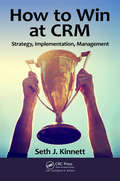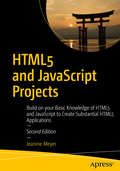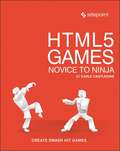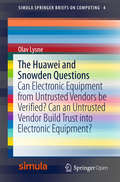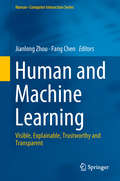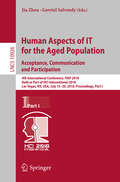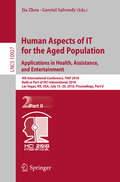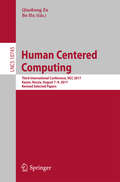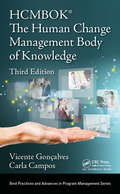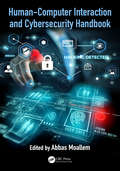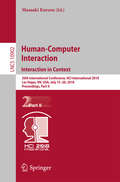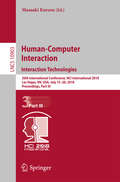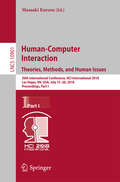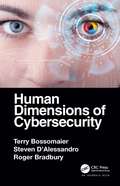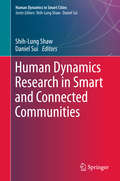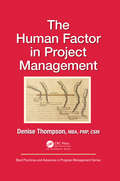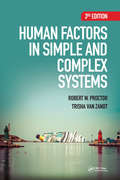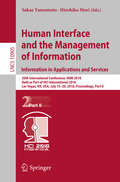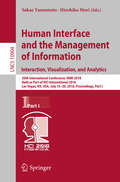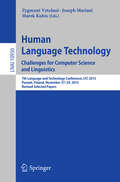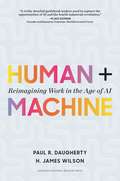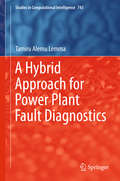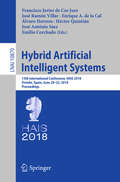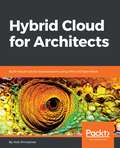- Table View
- List View
How to Win at CRM: Strategy, Implementation, Management
by Seth KinnettThis book provides clarity and guidance on effective strategy, implementation and management of CRM. It explores both the conceptual and cultural context of CRM initiatives along with the particulars of CRM system implementation and management. In order to provide this clarity, it surveyed the existing academic publications surrounding CRM, sales force automation, and related topics within information systems literature. The book supplements this research with insights from CRM experts to provide a robust picture of the CRM landscape and how to improve it no matter what role you play within your organization. This book is for everyone who wants to achieve CRM success.
HTML5 and JavaScript Projects
by Jeanine MeyerBuild on your basic knowledge of HTML5 and JavaScript to create substantial HTML5 applications. Through the many interesting projects you can create in this book, you'll develop HTML5 skills for future projects, and extend the core skills you may have learned with its companion book, The Essential Guide to HTML5. HTML5 and JavaScript Projects is fully updated as a second edition and covers important programming techniques and HTML, CSS, and JavaScript features to help you build projects with images, animation, video, audio and line drawings. You'll learn how to build games, quizzes and other interactive projects; incorporate the use of the Google Maps API and localStorage; and address the challenges of Responsive Design and Accessibility.Each project starts out with a description of the example's operation, often with full-color illustrations. You'll then review the HTML5 and JavaScript concepts that relate to the project followed by a step-by-step explanation of the programming used. Tables are used to show the relationship of functions and provide comments for each line of code so that you can easily apply the techniques to your own HTML5 projects.What You'll Learn Enhance your HTML5 and JavaScript programming skills.Poduce applications combining Canvas drawings, photos, and videos Incorporate Google Maps and geolocation into your projects Build applications requiring persistent data, storing the information locally or on a database on the server Who This Book Is ForDevelopers who have some knowledge of programming and want to build more substantial applications by combining basic features and combining JavaScript with other technologies.
HTML5 Games: Novice to Ninja
by Earle Castledine<p>This book will teach you how to create awesome video games. Games from scratch. Games that run cross-platform, in web browsers, and on phones. Games filled with dynamic sound and music. Games overflowing with impressive visual effects. Fun games. <p>More importantly, this book will teach you how to think about making games. You'll learn to analyze and dissect games; to understand what it is that makes great games great. By the end of the journey you'll have all the knowledge and tools needed to produce engaging, polished products that people will love to play. <p>What's inside? <p> <li>Learn the basics: game loops and input <li>Draw graphics on the screen using Canvas <li>Add amazing sound effects and music using the Web Audio API <li>Develop several fun games: a platformer, a shoot em up, a dungeon crawler, and a physics-based game <li>Create your own JavaScript game library <li>Jazz up your game up with "juice": screen shakes, particle effects, and more</li> </p>
The Huawei and Snowden Questions
by Olav LysneThis open access book answers two central questions: firstly, is it at all possible to verify electronic equipment procured from untrusted vendors? Secondly, can I build trust into my products in such a way that I support verification by untrusting customers? In separate chapters the book takes readers through the state of the art in fields of computer science that can shed light on these questions. In a concluding chapter it discusses realistic ways forward. In discussions on cyber security, there is a tacit assumption that the manufacturer of equipment will collaborate with the user of the equipment to stop third-party wrongdoers. The Snowden files and recent deliberations on the use of Chinese equipment in the critical infrastructures of western countries have changed this. The discourse in both cases revolves around what malevolent manufacturers can do to harm their own customers, and the importance of the matter is on par with questions of national security.This book is of great interest to ICT and security professionals who need a clear understanding of the two questions posed in the subtitle, and to decision-makers in industry, national bodies and nation states.
Human and Machine Learning: Visible, Explainable, Trustworthy and Transparent (Human–Computer Interaction Series)
by Jianlong Zhou Fang ChenWith an evolutionary advancement of Machine Learning (ML) algorithms, a rapid increase of data volumes and a significant improvement of computation powers, machine learning becomes hot in different applications. However, because of the nature of “black-box” in ML methods, ML still needs to be interpreted to link human and machine learning for transparency and user acceptance of delivered solutions. This edited book addresses such links from the perspectives of visualisation, explanation, trustworthiness and transparency. The book establishes the link between human and machine learning by exploring transparency in machine learning, visual explanation of ML processes, algorithmic explanation of ML models, human cognitive responses in ML-based decision making, human evaluation of machine learning and domain knowledge in transparent ML applications. This is the first book of its kind to systematically understand the current active research activities and outcomes related to human and machine learning. The book will not only inspire researchers to passionately develop new algorithms incorporating human for human-centred ML algorithms, resulting in the overall advancement of ML, but also help ML practitioners proactively use ML outputs for informative and trustworthy decision making. This book is intended for researchers and practitioners involved with machine learning and its applications. The book will especially benefit researchers in areas like artificial intelligence, decision support systems and human-computer interaction.
Human Aspects of IT for the Aged Population. Acceptance, Communication and Participation: 4th International Conference, ITAP 2018, Held as Part of HCI International 2018, Las Vegas, NV, USA, July 15–20, 2018, Proceedings, Part I (Lecture Notes in Computer Science #10926)
by Jia Zhou Gavriel SalvendyThis book constitutes the proceedings of the 4th International Conference onHuman Aspects of IT for the Aged Population, ITAP 2018, held as part of the 20th International Conference, HCI International 2018, which took place in Las Vegas, Nevada, in July 2018.The total of 1171 papers and 160 posters included in the 30 HCII 2018 proceedings volumes was carefully reviewed and selected from 4346 submissions. ITAP 2018 includes a total of 84 papers. They were organized in topical sections as follows: Part I: aging and technology acceptance; aging and interaction; intergenerational communication and social participation. Part II: health care technologies and services for the elderly; intelligent environments for aging; and games and entertainment for the elderly.
Human Aspects of IT for the Aged Population. Applications in Health, Assistance, and Entertainment: 4th International Conference, ITAP 2018, Held as Part of HCI International 2018, Las Vegas, NV, USA, July 15–20, 2018, Proceedings, Part II (Lecture Notes in Computer Science #10927)
by Jia Zhou Gavriel SalvendyThis book constitutes the proceedings of the 4th International Conference onHuman Aspects of IT for the Aged Population, ITAP 2018, held as part of the 20th International Conference, HCI International 2018, which took place in Las Vegas, Nevada, in July 2018. The total of 1171 papers and 160 posters included in the 30 HCII 2018 proceedings volumes was carefully reviewed and selected from 4346 submissions. ITAP 2018 includes a total of 84 papers. They were organized in topical sections as follows: Part I: aging and technology acceptance; aging and interaction; intergenerational communication and social participation. Part II: health care technologies and services for the elderly; intelligent environments for aging; and games and entertainment for the elderly.
Human Centered Computing
by Qiaohong Zu Bo HuThis book constitutes revised selected papers from the thoroughly refereed proceedings of the Third International Human Centered Computing Conference, HCC 2017, that consolidated and further develops the successful ICPCA/SWS conferences on Pervasive Computing and the Networked World, and which was held in Kazan, Russia, in August 2017. The 48 full and 20 short papers presented in this book together with 2 invited keynotes were carefully reviewed and selected from numerous submissions. This proceedings present recent advances in human machine interfaces, wireless and mobile network technologies, and data analytics, which make computer services truly human-centric.
The Human Change Management Body of Knowledge (Best Practices in Portfolio, Program, and Project Management)
by Vicente Goncalves Carla Campos"I am happy to recommend this work. I believe in the principles presented in it and identify with its context. Due to the lack of knowledge on the subject in the market, it is a topic that must be made known. The book should be in the library of all project and change managers."— Paul Dinsmore, PMI Fellow "Every manager should integrate HCMBOK® practices into their project management methodology in order to fully develop their work. This book addresses a simple and practical way that the critical component in organizational change management can be applied to projects of all kinds: the human factor."— Bruno Machado, Director, Project Management Office, Grupo Anima Educação "We live in a time of change, speed, and an avalanche of information. It is still very difficult for most companies to change their organizational culture efficiently. This book makes us reflect upon the crucial element in any change, and which most managers do not place in the foreground—the people." — Joyce Meyer, CEO, iDigo "In today's constantly changing world, the Project Manager must have sensitivity to how people react to change. Knowing a method that provides a structured way to take care of the human aspect is a key factor in the success of any project! HCMBOK® offers a simple and practical approach to managing change, which can be easily incorporated into the project management routine, providing amazing results."— Pedro Augusto Cardoso da Silva, Engineering Director, METRÔRIO This reference starts by presenting the concept of change management, its players, strategies, and applicable models. In the second part, the book covers the set of good practices, methodology, and tools known as the HCMBOK®— Human Change Management Body of Knowledge. The third part introduces the concept of the Change Management Office (CMO) and its relation to the strategic planning of an organization. The book concludes with the competencies essential for a change manager, an approach to agile methodologies, and a model for managing cultural change.
Human-Computer Interaction and Cybersecurity Handbook (Human Factors and Ergonomics)
by Abbas Moallem<P><P>Recipient of the SJSU San Jose State University Annual Author & Artist Awards 2019 <P><P>Recipient of the SJSU San Jose State University Annual Author & Artist Awards 2018 <P><P>Cybersecurity, or information technology security, focuses on protecting computers and data from criminal behavior. The understanding of human performance, capability, and behavior is one of the main areas that experts in cybersecurity focus on, both from a human–computer interaction point of view, and that of human factors. This handbook is a unique source of information from the human factors perspective that covers all topics related to the discipline. It includes new areas such as smart networking and devices, and will be a source of information for IT specialists, as well as other disciplines such as psychology, behavioral science, software engineering, and security management. <P><P>Features <li>Covers all areas of human–computer interaction and human factors in cybersecurity <li>Includes information for IT specialists, who often desire more knowledge about the human side of cybersecurity <li>Provides a reference for other disciplines such as psychology, behavioral science, software engineering, and security management <li>Offers a source of information for cybersecurity practitioners in government agencies and private enterprises <li>Presents new areas such as smart networking and devices
Human-Computer Interaction. Interaction in Context: 20th International Conference, HCI International 2018, Las Vegas, NV, USA, July 15–20, 2018, Proceedings, Part II (Lecture Notes in Computer Science #10902)
by Masaaki KurosuThe 3 volume-set LNCS 10901, 10902 + 10903 constitutes the refereed proceedings of the 20th International Conference on Human-Computer Interaction, HCI 2018, which took place in Las Vegas, Nevada, in July 2018. The total of 1171 papers and 160 posters included in the 30 HCII 2018 proceedings volumes was carefully reviewed and selected from 4346 submissions. HCI 2018 includes a total of 145 papers; they were organized in topical sections named: Part I: HCI theories, methods and tools; perception and psychological issues in HCI; emotion and attention recognition; security, privacy and ethics in HCI. Part II: HCI in medicine; HCI for health and wellbeing; HCI in cultural heritage; HCI in complex environments; mobile and wearable HCI. Part III: input techniques and devices; speech-based interfaces and chatbots; gesture, motion and eye-tracking based interaction; games and gamification.
Human-Computer Interaction. Interaction Technologies: 20th International Conference, HCI International 2018, Las Vegas, NV, USA, July 15–20, 2018, Proceedings, Part III (Lecture Notes in Computer Science #10903)
by Masaaki KurosuThe 3 volume-set LNCS 10901, 10902 + 10903 constitutes the refereed proceedings of the 20th International Conference on Human-Computer Interaction, HCI 2018, which took place in Las Vegas, Nevada, in July 2018. The total of 1171 papers and 160 posters included in the 30 HCII 2018 proceedings volumes was carefully reviewed and selected from 4346 submissions. HCI 2018 includes a total of 145 papers; they were organized in topical sections named: Part I: HCI theories, methods and tools; perception and psychological issues in HCI; emotion and attention recognition; security, privacy and ethics in HCI. Part II: HCI in medicine; HCI for health and wellbeing; HCI in cultural heritage; HCI in complex environments; mobile and wearable HCI. Part III: input techniques and devices; speech-based interfaces and chatbots; gesture, motion and eye-tracking based interaction; games and gamification.
Human-Computer Interaction. Theories, Methods, and Human Issues: 20th International Conference, HCI International 2018, Las Vegas, NV, USA, July 15–20, 2018, Proceedings, Part I (Lecture Notes in Computer Science #10901)
by Masaaki KurosuThe 3 volume-set LNCS 10901, 10902 + 10903 constitutes the refereed proceedings of the 20th International Conference on Human-Computer Interaction, HCI 2018, which took place in Las Vegas, Nevada, in July 2018. The total of 1171 papers and 160 posters included in the 30 HCII 2018 proceedings volumes was carefully reviewed and selected from 4346 submissions. HCI 2018 includes a total of 145 papers; they were organized in topical sections named: Part I: HCI theories, methods and tools; perception and psychological issues in HCI; emotion and attention recognition; security, privacy and ethics in HCI. Part II: HCI in medicine; HCI for health and wellbeing; HCI in cultural heritage; HCI in complex environments; mobile and wearable HCI. Part III: input techniques and devices; speech-based interfaces and chatbots; gesture, motion and eye-tracking based interaction; games and gamification.
Human Dimensions of Cybersecurity
by Terry Bossomaier Steven D'Alessandro Roger Bradbury"In Human Dimensions of Cyber Security, Terry Bossomaier, Steven D’Alessandro, and Roger Bradbury have produced a book that … shows how it is indeed possible to achieve what we all need; a multidisciplinary, rigorously researched and argued, and above all accessible account of cybersecurity — what it is, why it matters, and how to do it." --Professor Paul Cornish, Visiting Professor, LSE IDEAS, London School of Economics Human Dimensions of Cybersecurity explores social science influences on cybersecurity. It demonstrates how social science perspectives can enable the ability to see many hazards in cybersecurity. It emphasizes the need for a multidisciplinary approach, as cybersecurity has become a fundamental issue of risk management for individuals, at work, and with government and nation states. This book explains the issues of cybersecurity with rigor, but also in simple language, so individuals can see how they can address these issues and risks. The book provides simple suggestions, or cybernuggets, that individuals can follow to learn the dos and don’ts of cybersecurity. The book also identifies the most important human and social factors that affect cybersecurity. It illustrates each factor, using case studies, and examines possible solutions from both technical and human acceptability viewpoints.
Human Dynamics Research in Smart and Connected Communities
by Shih-Lung Shaw Daniel SuiThis book addresses how accelerating advances in information and communication technology, mobile technology, and location-aware technology have fundamentally changed the ways how social, political, economic and transportation systems work in today’s globally connected world. It delivers on many exciting research questions related to human dynamics at both disaggregate and aggregate levels that attract the attention of researchers from a wide range of disciplines. Human Dynamics Research involves theoretical perspectives, space-time analytics, modeling human dynamics, urban analytics, social media and big data, travel dynamics, privacy issues, development of smart cities, and problems and prospects of human dynamics research. This book includes contributions on theoretical, technical, or application aspects of human dynamics research from different disciplines. Appealing to researchers, scholars and students across a wide range of topics and disciplines including: urban studies, space-time, mobility and the internet, social media, big data, behavioral geography and spatio-temporal-network visualization, this book offers a glimpse at the cutting edge of research on human dynamics.
The Human Factor in Project Management (Best Practices in Portfolio, Program, and Project Management)
by Denise ThompsonIn the fluid world of changing business environments and variables affecting projects, a style of project management that primarily relies on maintaining the Iron Triangle, that tenuous mix of schedule, scope, and budgets, is no longer the sole path to success. Today’s project management demands a focus on leadership of the kind that anticipates and embraces change, challenges the status quo, and inspires teams. Developing these skills requires a mastery of emotional intelligence, courage, critical thinking, and a desire to become a true leader dedicated to developing success. Whether you are participating in a project for the first time or you’ve been doing projects for decades, you know the very essence of a project is to return value that gains a competitive edge and propels the organization forward into new frontiers. Whether you believe the best results are earned through agile, waterfall, or a mix of methodologies, project leadership is the secret weapon that will maintain and grow professional relevance, knowledge, and value in today’s workforce. Through a series of notable lessons in human history and behavior, The Human Factor in Project Management takes you on a journey of self-discovery to define your capabilities and gaps, while building your leadership skills. In your role as a project manager, project sponsor, product owner, or champion, the book challenges you to question the choices you make in a series of stories where you are the main character. This guide to career and personal growth forces you to look beyond the limitations of a Gantt chart, spreadsheet, or a Kanban board to evaluate the value from every tool you use and every action you take.
Human Factors in Simple and Complex Systems, Third Edition
by Robert W. Proctor Trisha Van ZandtRecently, there have been a number of advances in technology, including in mobile devices, globalization of companies, display technologies and healthcare, all of which require significant input and evaluation from human factors specialists. Accordingly, this textbook has been completely updated, with some chapters folded into other chapters and new chapters added where needed. The text continues to fill the need for a textbook that bridges the gap between the conceptual and empirical foundations of the field.
Human Interface and the Management of Information. Information in Applications and Services: 20th International Conference, HIMI 2018, Held as Part of HCI International 2018, Las Vegas, NV, USA, July 15-20, 2018, Proceedings, Part II (Lecture Notes in Computer Science #10905)
by Sakae Yamamoto Hirohiko MoriThis two-volume set LNCS 10904 and 10905 constitutes the refereed proceedings of the 20th International Conference on Human Interface and the Management of Information, HIMI 2018, held as part of HCI International 2018 in Las Vegas, NV, USA, in July 2018.The total of 1170 papers and 195 posters included in the 30 HCII 2018 proceedings volumes was carefully reviewed and selected from 4373 submissions.The 53 papers presented in this volume were organized in topical sections named: interacting with information; information and learning; information in aviation and transport; intelligent systems; and sevice management.
Human Interface and the Management of Information. Interaction, Visualization, and Analytics: 20th International Conference, HIMI 2018, Held as Part of HCI International 2018, Las Vegas, NV, USA, July 15-20, 2018, Proceedings, Part I (Lecture Notes in Computer Science #10904)
by Sakae Yamamoto Hirohiko MoriThis two-volume set LNCS 10904 and 10905 constitutes the refereed proceedings of the 20th International Conference on Human Interface and the Management of Information, HIMI 2018, held as part of HCI International 2018 in Las Vegas, NV, USA, in July 2018.The total of 1170 papers and 195 posters included in the 30 HCII 2018 proceedings volumes was carefully reviewed and selected from 4373 submissions.The 56 papers presented in this volume were organized in topical sections named: information visualization; multimodal interaction; information in virtual and augmented reality; information and vision; and text and data mining and analytics.
Human Language Technology. Challenges for Computer Science and Linguistics: 7th Language and Technology Conference, LTC 2015, Poznań, Poland, November 27-29, 2015, Revised Selected Papers (Lecture Notes in Computer Science #10930)
by Zygmunt Vetulani Joseph Mariani Marek KubisThis book constitutes the refereed proceedings of the 7h Language and Technology Conference: Challenges for Computer Science and Linguistics, LTC 2015, held in Poznan, Poland, in November 2015. The 31 revised papers presented in this volume were carefully reviewed and selected from 108 submissions. The papers selected to this volume belong to various fields of: Speech Processing; Multiword Expressions; Parsing; Language Resources and Tools; Ontologies and Wordnets; Machine Translation; Information and Data Extraction; Text Engineering and Processing; Applications in Language Learning; Emotions, Decisions and Opinions; Less-Resourced Languages.
Human + Machine: Reimagining Work In The Age Of AI
by Paul R. Daugherty H. James WilsonIn Human + Machine, Accenture leaders Paul R. Daugherty and H. James (Jim) Wilson show that the essence of the AI paradigm shift is the transformation of all business processes within an organization--whether related to breakthrough innovation, everyday customer service, or personal productivity habits. As humans and smart machines collaborate ever more closely, work processes become more fluid and adaptive, enabling companies to change them on the fly--or to completely reimagine them. AI is changing all the rules of how companies operate. <p><p> Based on the authors' experience and research with 1,500 organizations, the book reveals how companies are using the new rules of AI to leap ahead on innovation and profitability, as well as what you can do to achieve similar results. It describes six entirely new types of hybrid human + machine roles that every company must develop, and it includes a "leader’s guide" with the five crucial principles required to become an AI-fueled business. <p> Human + Machine provides the missing and much-needed management playbook for success in our new age of AI.
Human Rights Law and Regulating Freedom of Expression in New Media: Lessons from Nordic Approaches (Routledge Research in Human Rights Law)
by Mart Susi Jukka Viljanen Eiríkur Jónsson Artūrs KučsThe Nordic countries are well known globally for their high human rights standards and, at the same time, high degree of internet freedom. This edited collection reveals how the Nordic countries have succeeded in the task of protecting freedom of expression in the new media. It contains an overview of public policy choices and best practices of domestic online companies, which have the aspiration of finding global acceptance. Reviewing the topic of freedom of expression in new media within Nordic and Baltic countries, this book incorporates both general themes and interesting country-specific themes that will provide wider knowledge on the development of freedom of expression and media law in the online media era. A comprehensive analysis of regulation of online media, both at the level of legislation and application of law in courts and other authorities, are included. This book will contribute to the ongoing discussion as to whether there is a need to modify prevailing interpretation of freedom of expression. Human Rights Law and Regulating Freedom of Expression in New Media focuses on the multi-layered and complicated relationship between internet and human rights law. It contributes to the ongoing discussion regarding the protection of freedom of expression on the internet in the context of various doctrines of constitutional law, including the proliferation of constitutional adjudication. It will be of interest to researchers, academics, policymakers, and students in the fields of human rights law, internet law, political science, sociology, cultural studies, media and communications studies and technology.
A Hybrid Approach for Power Plant Fault Diagnostics (Studies in Computational Intelligence #743)
by Tamiru Alemu LemmaThis book provides a hybrid approach to fault detection and diagnostics. It presents a detailed analysis related to practical applications of the fault detection and diagnostics framework, and highlights recent findings on power plant nonlinear model identification and fault diagnostics. The effectiveness of the methods presented is tested using data acquired from actual cogeneration and cooling plants (CCPs). The models presented were developed by applying Neuro-Fuzzy (NF) methods. The book offers a valuable resource for researchers and practicing engineers alike.
Hybrid Artificial Intelligent Systems: 13th International Conference, HAIS 2018, Oviedo, Spain, June 20-22, 2018, Proceedings (Lecture Notes in Computer Science #10870)
by Francisco Javier de Cos Juez José Ramón Villar Enrique A. de la Cal Álvaro Herrero Héctor Quintián José António Sáez Emilio CorchadoThis volume constitutes the refereed proceedings of the 13th International Conference on Hybrid Artificial Intelligent Systems, HAIS 2018, held in Oviedo, Spain, in June 2018.The 62 full papers published in this volume were carefully reviewed and selected from 104 submissions. They are organized in the following topical sections: Neurocomputing, fuzzy systems, rough sets, evolutionary algorithms, Agents andMultiagent Systems, and alike.
Hybrid Cloud for Architects: Build robust hybrid cloud solutions using AWS and OpenStack
by David Duncan Alok ShrivastwaBuild your own hybrid cloud strategy with this comprehensive learning guide. Key Features Build a hybrid cloud strategy for your organization with AWS and OpenStack Leverage Hybrid Cloud to design a complex deployment pipeline Learn to implement security and monitoring best practices with real-world examples Book Description Hybrid cloud is currently the buzz word in the cloud world. Organizations are planning to adopt hybrid cloud strategy due to its advantages such as untested workloads, cloud-bursting, cloud service brokering and so on. This book will help you understand the dynamics, design principles, and deployment strategies of a Hybrid Cloud. You will start by understanding the concepts of hybrid cloud and the problems it solves as compared to a stand-alone public and private cloud. You will be delving into the different architecture and design of hybrid cloud. The book will then cover advanced concepts such as building a deployment pipeline, containerization strategy, and data storage mechanism. Next up, you will be able to deploy an external CMP to run a Hybrid cloud and integrate it with your OpenStack and AWS environments. You will also understand the strategy for designing a Hybrid Cloud using containerization and work with pre-built solutions like vCloud Air, VMware for AWS, and Azure Stack. Finally, the book will cover security and monitoring related best practices that will help you secure your cloud infrastructure. By the end of the book, you will be in a position to build a hybrid cloud strategy for your organization. What you will learn Learn the demographics and definitions of Hybrid Cloud Understand the different architecture and design of Hybrid Cloud Explore multi-cloud strategy and use it with your hybrid cloud Implement a Hybrid Cloud using CMP / Common API’s Implement a Hybrid Cloud using Containers Overcome various challenges and issues while working with your Hybrid Cloud Understand how to monitor your Hybrid Cloud Discover the security implications in the Hybrid CloudWho this book is for This book is targeted at cloud architects, cloud solution providers, DevOps engineers, or any working stakeholder who wants to learn about the hybrid cloud architecture. A basic understanding of public and private cloud is desirable.
